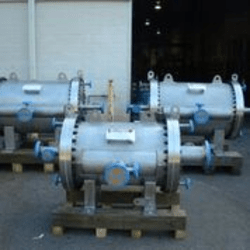Plate fin heat exchangers are compact and highly efficient devices used in various industrial applications to transfer heat between two fluids. They consist of a series of alternating flat plates and finned layers, creating a large surface area for effective heat exchange. Plate fin heat exchanger offer numerous advantages, including high thermal efficiency, compact size, and versatility, making them a popular choice in industries such as aerospace, automotive, power generation, and chemical processing. In this article, we will explore the working principles, benefits, and applications of plate fin heat exchangers.
Working Principles of Plate Fin Heat Exchangers
Plate fin heat exchangers work based on the principle of heat conduction and forced convection. They are designed to transfer heat between two fluids that flow in separate channels. The primary fluid (often referred to as the “hot” fluid) releases thermal energy, while the secondary fluid (referred to as the “cold” fluid) absorbs the heat.
The plate fin heat exchanger consists of multiple layers of flat plates separated by corrugated or finned layers. These layers create narrow channels through which the fluids flow. The alternating layers of plates and fins serve two main purposes: increasing the heat transfer surface area and enhancing fluid flow turbulence. This combination promotes efficient heat exchange by maximizing the contact between the fluids and the heat transfer surfaces.
The hot fluid flows through one set of channels while the cold fluid passes through the adjacent channels. As the fluids flow in opposite directions, heat is transferred from the hot fluid to the cold fluid through conduction and convection. The fins or corrugations increase the surface area, allowing for enhanced heat transfer. The fluids are typically separated by thin walls to prevent mixing while facilitating heat transfer.
Benefits of Plate Fin Heat Exchangers
Plate fin heat exchangers offer several advantages that make them a preferred choice in various industries:
1. High Thermal Efficiency
Plate fin heat exchangers provide excellent thermal efficiency due to their large surface area and optimized fluid flow patterns. The corrugated or finned layers enhance turbulence and promote efficient heat transfer, resulting in high overall heat transfer coefficients. This efficiency allows for compact designs and reduces the energy requirements for heating or cooling processes.
2. Compact Size
Plate fin heat exchangers are known for their compact size and high surface area-to-volume ratio. The stacked plate and fin design allows for a large heat transfer area within a relatively small footprint. This compactness makes them suitable for installations with space constraints, allowing for efficient heat transfer even in limited areas.
3. Versatility and Customization
Plate fin heat exchangers can be customized to meet specific heat transfer requirements. The number of plates, fin density, and channel arrangements can be adjusted to optimize heat transfer performance for different fluids and operating conditions. This versatility makes them suitable for a wide range of applications, from cooling hydraulic systems in aircraft to recovering waste heat in industrial processes.
4. Lightweight Construction
Plate fin heat exchangers are often constructed using lightweight materials such as aluminum alloys. This lightweight construction offers benefits such as reduced installation and transportation costs, improved ease of handling, and decreased structural load on the supporting system.
5. Resistance to Corrosion and Thermal Stress
Many plate fin heat exchangers are made from materials that exhibit high corrosion resistance and thermal stability. This allows them to withstand aggressive operating environments, such as those involving corrosive fluids or high-temperature differentials. The use of corrosion-resistant coatings or materials ensures long-term performance and durability.
6. Easy Maintenance and Cleaning
Plate fin heat exchangers are designed for easy maintenance and cleaning. The compact and modular design allows for easy access to the heat transfer surfaces, facilitating inspection, repair, and cleaning operations. Regular maintenance ensures optimal performance and prolongs the lifespan of the heat exchanger.
Applications of Plate Fin Heat Exchangers
Plate fin heat exchangers find applications in various industries where efficient heat transfer is critical. Some common applications include:
1. Aerospace and Aviation
Plate fin heat exchangers are widely used in aerospace applications, such as aircraft and spacecraft, for cooling hydraulic systems, engine oil, and fuel. The compact and lightweight design of plate fin heat exchangers is ideal for space-constrained aircraft environments, where efficient heat dissipation is essential for system performance and reliability.
2. Automotive and Transportation
Plate fin heat exchangers are employed in automotive and transportation applications, including engine cooling, transmission oil cooling, and air conditioning systems. Their compact size, high thermal efficiency, and lightweight construction contribute to improved vehicle performance, fuel efficiency, and passenger comfort.
3. Power Generation
Plate fin heat exchangers are utilized in power generation facilities, including gas turbines, combined cycle power plants, and nuclear power plants. They play a crucial role in cooling various fluids, such as turbine oil, generator hydrogen, and reactor cooling water, ensuring efficient and reliable power generation.
4. Chemical and Petrochemical Industries
In the chemical and petrochemical sectors, plate fin heat exchangers are used for heat recovery, process cooling, and condensation of vapors. Their versatility and high thermal efficiency make them suitable for handling a wide range of corrosive fluids, high-temperature differentials, and demanding operating conditions.
5. HVAC and Refrigeration
Plate fin heat exchangers are commonly found in HVAC (Heating, Ventilation, and Air Conditioning) systems and refrigeration applications. They facilitate heat transfer between air and refrigerant in evaporators, condensers, and heat pump systems, ensuring efficient temperature control and energy efficiency.
Conclusion
Plate fin heat exchangers provide efficient heat transfer solutions for various industries, offering high thermal efficiency, compact size, and versatility. Their ability to handle a wide range of fluids, high-temperature differentials, and corrosive environments makes them suitable for diverse applications. Whether in aerospace, automotive, power generation, or chemical processing, plate fin heat exchangers play a crucial role in optimizing energy usage, improving system performance, and ensuring reliable operation. With their compact design, customization options, and ease of maintenance, plate fin heat exchanger continue to be a preferred choice for efficient heat transfer in a range of industrial processes.




